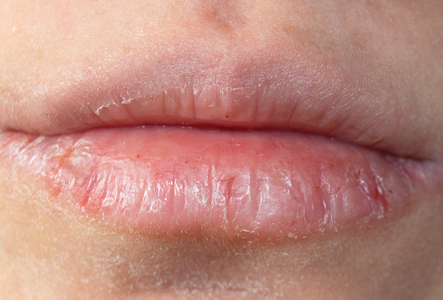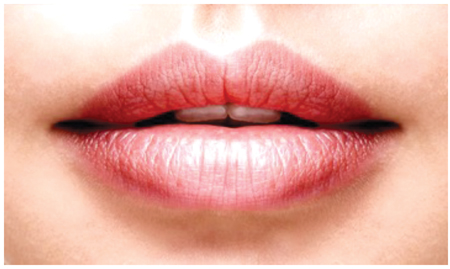Lips are defined as “either of two fleshy folds that surround the mouth in humans and many other vertebrates and are organs of human speech essential to certain articulations”1. Lips are unique oral structures, as individual as fingerprints, that play important roles in mastication and deglutition, sound articulation, facial expression and physiological protection. Lips are also tactile organs and erogenous zones. They are the central defining aesthetic feature of the lower third of the face, distinct from the surrounding skin, contributing significantly to our perceptions of health, beauty, vitality, and how we interact with our environment. But mention the word “lips” to most dental practitioners and they think of inconvenient bits of flaccid tissue covering the important stuff underneath; structures that just get in the way of dental treatment. Many dentists wish that lips were somehow detachable!
In fact, even those practitioners who do give greater thought to these oral soft tissues, do so from a perspective of screening for pathology. More recently, an increasing number of practitioners have begun offering facial injectable treatments such as dermal filler, to correct defects or age-related aesthetic changes, but only once they have occurred. Very few dental practitioners acknowledge the importance and uniqueness of lips to the point where they perceive them as they do the teeth and gingivae, focusing on health maintenance and disorder prevention, so as to reduce the need for intervention at a later date.
This is due, in large part, to lips and other facial soft tissues being given no more than a cursory discussion (at best) in traditional dental training that focuses on dentition and periodontium. Fortunately, professional lip care treatment that can be delivered by hygienists, dentists and therapists at every recall visit or indeed, at the end of any dental appointment is now part of the armamentarium. The dental team can now access a revolutionary approach designed to pay lips the service they are long overdue. (Lip-TxTM, www.lip-tx.com)
Lips need special treatment
Lip appearance has a major impact on facial esthetics but can also serve as an indicator of general health. Much as other parts of the orofacial complex, they are exposed to pathology and weakening as a result of the ageing process (loss of supportive collagen, elastin and extracellular matrix components); the constant contraction of the underlying orbicularis oris muscle; environmental insults (including smoking, drinking, eating, UV radiation, dental visits/materials) compounded by a lack of care.2
Lips represent the histological transition between the mucosal membrane and the outer facial skin. Facial skin has a 16-cell thickness protective, keratinized surface layer (stratum corneum). Lip tissue is comprised of non-keratinized epithelium, only 3 cells thick.3 This histological difference is readily recognizable when comparing the color of skin and lips. (Fig.1) The red/pink lip color comes from the translucence of the underlying capillary network and the absence of a thick keratinized layer. These structures are also lacking melanocytes (pigment producing cells in the epidermis of normal skin provide UV protection).3
Fig. 1

The lack of the protective stratum corneum layer suggests that lips serve poorly as barriers. Their low moisture capacity,4 makes them prone to infection, pathology, desiccation, and puts them at daily risk of chemical and mechanical trauma: toothbrushing, lip-licking, mouth rinsing, eating and UV exposure.
Trans-Epidermal Water Loss (TEWL) is the amount of water that passively evaporates through the skin to the external environment (not by sweat, but due to the differential water vapor pressures on either side of the skin). TEWL measurement is a good gauge of the skin barrier integrity (an increase indicates impaired barrier function and correlates to skin ageing and deterioration).5 Research indicates that lips experience significantly greater TEWL than other skin structures, allowing many common dermatoses including cheilitis (lip inflammation) that leads to dryness, chapping, cracking, flaking, sores, bleeding, and more. (Fig.2)
Fig. 2A

Fig. 2B

Unlike skin, lips do not have hair follicles, sebaceous or sweat glands that aid in hydration and provide vital nutrients and antioxidants (Vitamin E). Research establishes that lips are vulnerable structures, lacking the innate protection capacity of the adjacent facial skin. Thus, lips experience daily physiological stress and deterioration at a faster rate and to a greater degree. Indeed, lip cancer represents the most common form of head and neck cancer (more in men than women), with squamous cell carcinoma (SCC) representing 90% of new cases. Lip SCC has a much higher risk of aggressive metastasis than similar lesions on other parts of the skin.6
Many people mistakenly think that lips are analogous to normal skin, requiring similar care and maintenance, and only when cracked. In fact, nothing could be farther from the truth – lips need special attention and regular professional maintenance to preserve their health and function and to avoid serious pathology.
The best lip care
Patients seeking information on optimal lip care are bombarded with a plethora of overwhelming and conflicting information. Much of this information is from deceitful manufacturers, questionable social media influencers, and/or celebrities with a vested interest. Poorly trained sales staff in department stores and supermarkets also contribute to the misinformation.
Dental practitioners are trusted experts in oral tissues and their primary duties include the promotion of oral health and proven oral hygiene procedures. In the contemporary dental practice, this guidance should extend to optimal lip care, that maintains lip appearance and health, and prevents pathology.
The dental team should recommend reliable lip care products with clinically proven ingredients such as antioxidants, humectants and emollients that supplement the inherent deficiencies in lip tissue composition. Protection against the UV rays of the sun is also crucial. Dermatologists and skin cancer specialists have warned about luxury branded, non-SPF, high-sheen, gloss products, which may permit the passage of damaging ultraviolet rays, permitting deeper tissue penetration, thereby increasing the risk of lip cancer.7
Tissue damage in the lips, even short of neoplastic changes, can lead to painful and unsightly photo-ageing, premature wrinkles, painful fissures, and solar keratosis (nonmalignant, yet unpleasant crusty nodules). Armed with this knowledge, it is the dental team’s responsibility to assist their patients’ utilization and selection of appropriate lip care products.
Clinical studies have indicated that the regular application of a professionally formulated, sequential, multi-step lip-care treatment results in significant improvements to lip health.8 The use of the Lip-Tx ProTM system (Fig. 3), at the end of each scheduled dental hygiene visit and all treatment appointments, along with the daily use of the Lip-Tx HomeTM product, has been shown to enhance the lip barrier function, reduce TEWL, protect the tissue from environmental damage, and offer SPF protection. The treatment protocol improves the overall condition of the tissue, reduces cracking, dryness and fine lines, and improves lip texture, color and definition.
Fig. 3

Long-term lip health
The most comprehensive method for ensuring healthy lip tissues throughout life involves regular check-ups and maintenance by a dental professional, and the daily use of clinically proven home-use products. Lip-Tx proTM is the world’s first, single-use, professional lip care system for protecting and enhancing lip health and aesthetics. Designed in Australia by a global oral health experts group, its formulation is based on the latest clinical research. The system’s powerful, synergistic, 3-step system consists of exfoliation, hydration, and protection phases, and takes less than 5 minutes to administer. Lip-Tx proTM can be utilized at the conclusion of any dental treatment which may compromise lip integrity.
Step 1: Exfoliation
The mechanical probiotic exfoliation serum is gently rubbed over the lips with gloved fingers in a gentle circular motion for 30 seconds. This process removes dead, dry, cracked, flaky and poorly desquamating surface cells. The mechanical stimulation also promotes blood flow and stimulates the production of vital collagen, elastin and extracellular matrix components via a dermis feedback loop, helping the lips maintain their volume and structure.9 Exfoliation also aids the penetration of the subsequent ingredients in the Lip-TxTM protocol. (Fig. 4)
Fig. 4

Step 2: Hydration
An innovative, plant-based “second skin” is adapted to the lips and left in place for several minutes. Rich in antioxidants and amino acids, the mask soothes the lips, relieving inflammation, and has been shown to notably improve the skin’s moisture content.10 (Fig. 5)
Fig. 5

Step 3: Protect (Fig.6):
Finally, a powerful antioxidant and peptide formula is gently rubbed over the lips with gloved fingers in a gentle circular motion for 30 seconds. This professional formulation utilizes the intense moisturizing power of hyaluronic acid, with Vitamin E protection and FDA-approved sunscreen blocking11 to provide long lasting lip preservation.
Fig. 6

In order to maintain lip health between professional visits, patients are also given a professional strength lip balm, Lip-Tx HomeTM (Fig.7), for daily use. Clinical studies have shown that three daily applications significantly improve key lip parameters.8
Fig. 7

Social media informs consumers, leading them to expect higher quality and greater value in their health and beauty choices. Professionally formulated, scientifically devised treatments and take-home products have boomed in popularity as they provide confidence in actual results.
Dental practitioners, faced with an increasingly competitive market, have sought to differentiate their practices. One of the most successful strategies is to offer more comprehensive service to patients. The development of professional, chairside lip care protocols and take-home recommendations benefits patients’ health and wellbeing. Lip-Txtm sets a new standard of care in regular dental maintenance, benefitting the future success of the dental practice.
Oral Health welcomes this original article.
References
- https://www.merriam-webster.com/dictionary/lips
- Klein AW. In search of the perfect lip: 2005. Dermatol Surg. 2005 Nov;31(11 Pt 2):1599-603.
- Zugerman C. The lips: anatomy and differential diagnosis. Cutis. 1986 Aug;38(2):116-20.
- Kobayashi H, Tagami H. Functional properties of the surface of the vermilion border of the lips are distinct from those of the facial skin. Br J Dermatol. 2004 Mar;150(3):
563-7. - Golara Honari, Howard Maibach, Applied Dermatotoxicology – Clinical Aspects Academic Press, 2014.
- M. Maruccia, M.G. Onesti, P. Parisi, E. Cigna, A. Troccola, N. Scuderi. Lip Cancer: A 10-Year Retrospective Epidemiological Study Anticancer Research Apr 2012, 32 (4) 1543-1546.
- https://abcnews.go.com/Health/BeautySecrets/story?id= 4766632&page=1
- Trookman NS, Rizer RL, Ford R, Mehta R, Gotz V. Clinical assessment of a combination liptreatment to restore moisturization and fullness. J Clin Aesthet Dermatol. 2009 Dec;2(12):44-8.
- Ganceviciene R, Liakou AI, Theodoridis A, Makrantonaki E, Zouboulis CC. Skin anti-aging strategies. Dermatoendocrinol. 2012;4(3):308-319.
- Journal of Pharmacy and Pharmacology, September 2019, pages 1,353-1,369
- Journal of Clinical Aesthetic Dermatology, 2013, issue 1, pages 16-26
- https://www.forbes.com/sites/sarabliss/2021/03/01/why-doctor-formulated-skincare-brands-are-disrupting-the-85-billion-dollar-beauty-industry/?sh=4384bf1ac556
About the Author
 Dr Myles Holt is the Director and Head Trainer at the Australasian Academy of Dento-Facial Aesthetics. He has authored the Facial Aesthetics Module and is an Honorary Lecturer for the Masters of Aesthetic Dentistry program at King’s College London and is a Regent of the International Academy of Dental and Facial Esthetics in New York. Dr Holt has a Masters in Health and Medical Law, a Masters in Aesthetic Medicine and is a sought after global presenter on the incorporation of various skin health and facial rejuvenation procedures in Dentistry.
Dr Myles Holt is the Director and Head Trainer at the Australasian Academy of Dento-Facial Aesthetics. He has authored the Facial Aesthetics Module and is an Honorary Lecturer for the Masters of Aesthetic Dentistry program at King’s College London and is a Regent of the International Academy of Dental and Facial Esthetics in New York. Dr Holt has a Masters in Health and Medical Law, a Masters in Aesthetic Medicine and is a sought after global presenter on the incorporation of various skin health and facial rejuvenation procedures in Dentistry.













